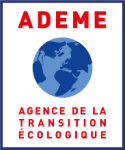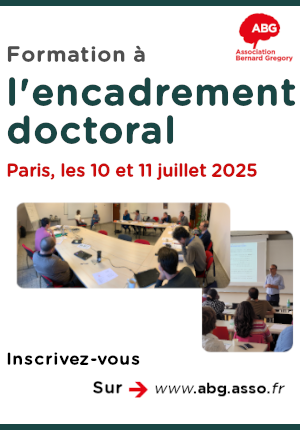Un jumeau numérique hospitalier pour l'optimisation des flux de patients dans les blocs opératoires d'urgence // A hospital digital twin for the optimization of patient flows in emergency operating rooms
|
ABG-131991
ADUM-66068 |
Sujet de Thèse | |
| 15/05/2025 | Autre financement public |
Université Paris-Saclay GS Sciences de l'ingénierie et des systèmes
Gif-sur-Yvette - Ile-de-France - France
Un jumeau numérique hospitalier pour l'optimisation des flux de patients dans les blocs opératoires d'urgence // A hospital digital twin for the optimization of patient flows in emergency operating rooms
Data analytics, salles d'opérations urgentes, machine learning, ingénierie des systèmes de santé, optimisation, modèles stochastiques
Data analytics, emergency operating rooms, machine learning, healthcare systems engineering, optimization, stochastic modeling
Data analytics, emergency operating rooms, machine learning, healthcare systems engineering, optimization, stochastic modeling
Description du sujet
Les principales causes de la surcharge des salles d'opération d'urgence (SOU) sont la demande croissante de chirurgies urgentes et la pénurie de personnel médical. Les effets de la surcharge peuvent malheureusement se répercuter sur l'ensemble de l'hôpital, entraînant une mortalité hospitalière plus forte, des séjours plus longs et des coûts plus élevés. Le projet de thèse est motivé par ce contexte, où il devient crucial de repenser l'ingénierie des opérations et l'optimisation des SOU. La thèse sera faite dans le cadre d'une collaboration étroite avec La Pitié Salpêtrière, un des plus grands hôpitaux en France et en Europe.
------------------------------------------------------------------------------------------------------------------------------------------------------------------------
------------------------------------------------------------------------------------------------------------------------------------------------------------------------
The overcrowding of Emergency Operating Rooms (EORs) has become a critical topic in the healthcare sector (De Simone et al., 2023). Amongst the main causes are the growing demand for non-elective surgeries, the closure of surgery wards in some hospitals to reduce overall system costs, and the unprecedented shortage of medical staff (Lepercq et al., 2021). This situation results in excessive waiting times and reduced access of EOR patients to healthcare services. Unfortunately, the effects of EOR overcrowding can ripple throughout the hospital, resulting in negative system-wide effects such as increasing in-hospital mortality, longer length of stays and higher costs (Santamaria-Acevedo, 2021). Therefore, optimizing EOR patient flows become one of the main priorities of healthcare managers.
The literature on the flow optimization for operating rooms is extensive, but it focuses mainly on elective surgeries (Samudra et al., 2016). Elective surgeries are those scheduled weeks or months in advance, typically involving lower uncertainty and process complexity. The works that incorporate non-elective patients employ simulation-based optimization techniques (Ozcan et al., 2017), as these are well-suited to capture the realistic and complex features of the problem (such as uncertainty in arrivals and activity delays, patient heterogeneity, etc.). However, these works focus on single-stage optimization problems (e.g., patient scheduling for the operating room) without considering the other hospital units involved in delivering patient care. Also, the scheduling problems are often formulated for a single optimization criterion (e.g. costs) and do not account for the inherent dynamics. Henceforth, there is a lack in the literature for studies that consider an integrated optimization for the EOR patient flows within the hospital units, considering healthcare system dynamics and accounting at the same time for multiple KPIs.
Moreover, several researchers believe that a Hospital Digital Twin (HDT) has the potential to facilitate new approaches for the optimization of hospital care activities, particularly by accounting for their dynamics (Elkefi and Asan, 2022; Xames and Topcu, 2024; Pellegrino et al., 2024). However, a digital twin has not yet been developed to support decision-makers in optimizing the delivery of EOR patient care.
The aim of this PhD thesis is to develop:
(1) novel optimization methods for the dynamic scheduling (prioritization) of EOR patients in the different hospital units, namely the EORs, the post-anesthesia care unit (PACU), the intensive care unit (ICU) and the ward. First, independent single-stage dynamic scheduling optimization problems will be formulated for each involved hospital unit using queueing models. Second, meta-heuristic algorithms (such as GAs), integrating the developed single-stage scheduling solutions, will be devised to build near-optimal solutions for the multi-objective global optimization of the EOR patient flows.
(2) a Discrete-Event Simulation (DES) model to evaluate pertinent KPIs of the studied healthcare system. These will include medical KPIs (such as a patient's length of stay in the hospital), social and human science KPIs (such as the work-life balance of hospital staff through stable workloads and minimized overtime), and cost-effectiveness KPIs (such as the cost incurred per patient).
(3) an HDT that allows to generate recommendations on how to prioritize EOR patients in the considered hospital units whenever a new request arrives. The development of HDT will include the definition of an appropriate scheme that integrates the optimization methods and the DES model, its implementation, verification, and validation using Entrepôt de Données de Santé-Assistance Publique Hôpitaux de Paris (EDS APHP) data.
------------------------------------------------------------------------------------------------------------------------------------------------------------------------
------------------------------------------------------------------------------------------------------------------------------------------------------------------------
Début de la thèse : 01/10/2025
------------------------------------------------------------------------------------------------------------------------------------------------------------------------
------------------------------------------------------------------------------------------------------------------------------------------------------------------------
The overcrowding of Emergency Operating Rooms (EORs) has become a critical topic in the healthcare sector (De Simone et al., 2023). Amongst the main causes are the growing demand for non-elective surgeries, the closure of surgery wards in some hospitals to reduce overall system costs, and the unprecedented shortage of medical staff (Lepercq et al., 2021). This situation results in excessive waiting times and reduced access of EOR patients to healthcare services. Unfortunately, the effects of EOR overcrowding can ripple throughout the hospital, resulting in negative system-wide effects such as increasing in-hospital mortality, longer length of stays and higher costs (Santamaria-Acevedo, 2021). Therefore, optimizing EOR patient flows become one of the main priorities of healthcare managers.
The literature on the flow optimization for operating rooms is extensive, but it focuses mainly on elective surgeries (Samudra et al., 2016). Elective surgeries are those scheduled weeks or months in advance, typically involving lower uncertainty and process complexity. The works that incorporate non-elective patients employ simulation-based optimization techniques (Ozcan et al., 2017), as these are well-suited to capture the realistic and complex features of the problem (such as uncertainty in arrivals and activity delays, patient heterogeneity, etc.). However, these works focus on single-stage optimization problems (e.g., patient scheduling for the operating room) without considering the other hospital units involved in delivering patient care. Also, the scheduling problems are often formulated for a single optimization criterion (e.g. costs) and do not account for the inherent dynamics. Henceforth, there is a lack in the literature for studies that consider an integrated optimization for the EOR patient flows within the hospital units, considering healthcare system dynamics and accounting at the same time for multiple KPIs.
Moreover, several researchers believe that a Hospital Digital Twin (HDT) has the potential to facilitate new approaches for the optimization of hospital care activities, particularly by accounting for their dynamics (Elkefi and Asan, 2022; Xames and Topcu, 2024; Pellegrino et al., 2024). However, a digital twin has not yet been developed to support decision-makers in optimizing the delivery of EOR patient care.
The aim of this PhD thesis is to develop:
(1) novel optimization methods for the dynamic scheduling (prioritization) of EOR patients in the different hospital units, namely the EORs, the post-anesthesia care unit (PACU), the intensive care unit (ICU) and the ward. First, independent single-stage dynamic scheduling optimization problems will be formulated for each involved hospital unit using queueing models. Second, meta-heuristic algorithms (such as GAs), integrating the developed single-stage scheduling solutions, will be devised to build near-optimal solutions for the multi-objective global optimization of the EOR patient flows.
(2) a Discrete-Event Simulation (DES) model to evaluate pertinent KPIs of the studied healthcare system. These will include medical KPIs (such as a patient's length of stay in the hospital), social and human science KPIs (such as the work-life balance of hospital staff through stable workloads and minimized overtime), and cost-effectiveness KPIs (such as the cost incurred per patient).
(3) an HDT that allows to generate recommendations on how to prioritize EOR patients in the considered hospital units whenever a new request arrives. The development of HDT will include the definition of an appropriate scheme that integrates the optimization methods and the DES model, its implementation, verification, and validation using Entrepôt de Données de Santé-Assistance Publique Hôpitaux de Paris (EDS APHP) data.
------------------------------------------------------------------------------------------------------------------------------------------------------------------------
------------------------------------------------------------------------------------------------------------------------------------------------------------------------
Début de la thèse : 01/10/2025
Nature du financement
Autre financement public
Précisions sur le financement
ANR
Présentation établissement et labo d'accueil
Université Paris-Saclay GS Sciences de l'ingénierie et des systèmes
Etablissement délivrant le doctorat
Université Paris-Saclay GS Sciences de l'ingénierie et des systèmes
Ecole doctorale
573 Interfaces : matériaux, systèmes, usages
Profil du candidat
Candidats intéressés par la recherche opérationnelle, le data science et le management des opérations en santé.
Candidates interested in operations research, data science and operations management for healthcare.
Candidates interested in operations research, data science and operations management for healthcare.
30/06/2025
Postuler
Fermer
Vous avez déjà un compte ?
Nouvel utilisateur ?
Besoin d'informations sur l'ABG ?
Vous souhaitez recevoir nos infolettres ?
Découvrez nos adhérents
 TotalEnergies
TotalEnergies  Tecknowmetrix
Tecknowmetrix  MabDesign
MabDesign  PhDOOC
PhDOOC  Institut Sup'biotech de Paris
Institut Sup'biotech de Paris  ASNR - Autorité de sûreté nucléaire et de radioprotection - Siège
ASNR - Autorité de sûreté nucléaire et de radioprotection - Siège  MabDesign
MabDesign  ONERA - The French Aerospace Lab
ONERA - The French Aerospace Lab  CASDEN
CASDEN  Laboratoire National de Métrologie et d'Essais - LNE
Laboratoire National de Métrologie et d'Essais - LNE  ADEME
ADEME  Aérocentre, Pôle d'excellence régional
Aérocentre, Pôle d'excellence régional  SUEZ
SUEZ  Généthon
Généthon  Groupe AFNOR - Association française de normalisation
Groupe AFNOR - Association française de normalisation  Ifremer
Ifremer  Nokia Bell Labs France
Nokia Bell Labs France  ANRT
ANRT  CESI
CESI







